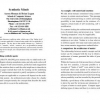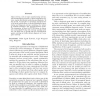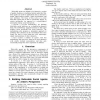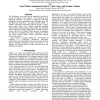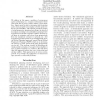AGENTS
1997
Springer
14 years 3 months ago
1997
Springer
This paper discusses conditions under which some of the “higher level” mental concepts applicable to human beings might also be applicable to artificial agents. The key idea ...
AGENTS
1997
Springer
14 years 3 months ago
1997
Springer
Transportable agents are autonomous programs. They can move through a heterogeneous network of computers under their own control, migrating from host to host. They can sense the s...
AGENTS
1997
Springer
14 years 3 months ago
1997
Springer
Many systems, such as large manufacturing systems, telecommunication networks, or homeautomation systems, require distributed monitoring and diagnosis. In this article, we introdu...
AGENTS
1997
Springer
14 years 3 months ago
1997
Springer
This paper presents a domain-independent architecture for facilitating visual problem solving between robots or softbots and humans. The architecture de
nes virtual and human agen...
AGENTS
1997
Springer
14 years 3 months ago
1997
Springer
This paper describes a novel method of achieving load balancing in telecommunications networks. A simulated network models a typical distribution of calls between arbitrary nodes;...
AGENTS
1997
Springer
14 years 3 months ago
1997
Springer
We take the position that autonomous agents, when they interact with people, should be governed by the same principles that underlie human collaboration. These principles come fro...
AGENTS
1997
Springer
14 years 3 months ago
1997
Springer
Believable agents are defined to be interactive versions of quality characters in traditional artistic media like film. Such agents are useful in applications such as interactive ...
AGENTS
1997
Springer
14 years 3 months ago
1997
Springer
The information access and retrieval capabilities provided by several conventional search engines, while improving upon traditional techniques, are lacking in supporting conceptua...
AGENTS
1997
Springer
14 years 3 months ago
1997
Springer
We address in this paper a problem of autonomous agents performing in a common environment where each agent has its goal to achieve before a given deadline. Agents must be able to...
AGENTS
1997
Springer
14 years 3 months ago
1997
Springer
The Patient Advocate is designed to be an intelligent assistant for patient-centered health care. Residing on a home computer or special-purpose device and operating within an ext...
